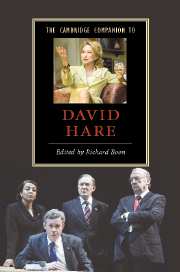13 - Performing histories
Plenty and A Map of the World
from Part IV - Overviews of Hare
Published online by Cambridge University Press: 28 April 2008
Summary
Writing about two of David Hare's epic plays from 1978 and 1982, I encounter history in syncopated time. Plenty, overtly historical, moves from 1943 to 1962 while A Map of the World, not marked by year in the text, was produced in 1982 and 1983, when preparations were already underway for an observation of 1985 as the 'Year of the United Nations'. A Map of the World can be linked productively to debates about the role of the United Nations at that time, while Plenty will benefit from attention both to the history of the years represented within the play, and also to concerns and events at the time of its first production. Then there is the third dimension of time, the time of this writing - when this chapter is intended to speak to contemporary readers who may not even have been born until after both of these other periods. David Hare and I were born in the same year, and the second time stratum examined here, the decade from 1975 to 1985, found both of us living and working as thirty-something contemporaries. 'Contemporary History' can seem like an oxymoron, but the important question of when experience is past enough to be viewed as history - perceived, analysed and treated as historical - is a valid and perplexing one for those of us engaged in the pursuit of a glimpse of the newly historical past.
- Type
- Chapter
- Information
- The Cambridge Companion to David Hare , pp. 200 - 219Publisher: Cambridge University PressPrint publication year: 2007

